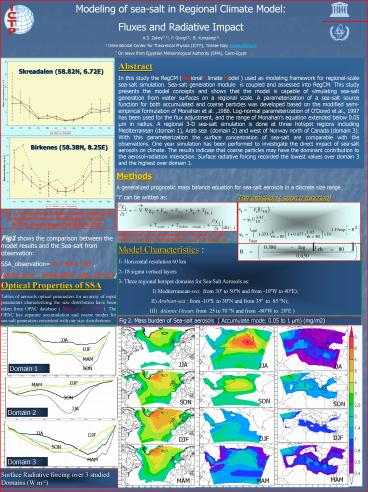Modeling of seasalt in Regional Climate Model: - PowerPoint PPT Presentation
1 / 1
Title:
Modeling of seasalt in Regional Climate Model:
Description:
Sea-salt generation module is coupled and assessed into RegCM. ... A parameterization of a sea-salt source function for both accumulated and coarse ... – PowerPoint PPT presentation
Number of Views:25
Avg rating:3.0/5.0
Title: Modeling of seasalt in Regional Climate Model:
1
Modeling of sea-salt in Regional Climate Model
Fluxes and Radiative Impact A.S. Zakey(,1), F.
Giorgi(1), B. Xunqiang(1) 1 International Center
for Theoretical Physics (ICTP), Trieste-Italy
azakey_at_ictp.it On leave from Egyptian
Meteorological Authority (EMA), Cairo-Egypt
Abstract In this study the RegCM (Regional
Climate Model ) used as modeling framework for
regional-scale sea-salt simulation. Sea-salt
generation module is coupled and assessed into
RegCM. This study presents the model concepts and
shows that the model is capable of simulating
sea-salt generation from water surfaces on a
regional scale. A parameterization of a sea-salt
source function for both accumulated and coarse
particles was developed based on the modified
semi-empirical formulation of Monahan et al.
,1986. Log-normal parameterization of ODowd et
al., 1997 has been used for the flux adjustment,
and the range of Monahans equation extended
below 0.05 µm in radius. A regional 3-D sea-salt
simulation is done at three hotspot regions
including Mediterranean (domain 1), Arab sea
(domain 2) and west of Norway north of Canada
(domain 3). With this parameterization the
surface concentration of sea-salt are comparable
with the observations. One year simulation has
been performed to investigate the direct impact
of sea-salt aerosols on climate. The results
indicate that coarse particles may have the
dominant contribution to the aerosol-radiation
interaction. Surface radiative forcing recorded
the lowest values over domain 3 and the highest
over domain 1.
Skreadalen (58.82N, 6.72E)
Birkenes (58.38N, 8.25E)
Methods A generalized prognostic mass balance
equation for sea-salt aerosols in a discrete size
range i can be written as
The emission ( source function)
Fig. 1, Comparison between observation and
predicted SSA over Skreadalen (58.82N, 6.72E) and
Birkenes (58.38N, 8.25E)
Where U10 is the wind speed at 10m and r is the
radius at relative humidity 80, and B is taken
as
Fig1 shows the comparison between the model
results and the Sea-salt from observation SSA_obs
ervation Cl Na x 1.47 , (Quinn et al.
Tellus(2000), 52B, 239-257)
Model Characteristics 1- Horizontal resolution
60 km 2- 18 sigma vertical layers 3- Three
regional hotspot domains for Sea-Salt Aerosols
as I)
Mediterranean-sea from 30º to 50ºN and from
-10ºW to 40ºE) II)
Arabian-sea from -10ºS to 30ºN and from 35º
to 85 ºN) III)
Atlantic Ocean from 25 to 70 ºN and from -80ºW
to 20ºE )
Optical Properties of SSA Tables of aerosols
optical parameters for an array of input
parameters characterizing the size distribution
have been taken from OPAC database ( Hess et al.,
1998 ). The OPAC has separate accumulation and
coarse modes for sea-salt generation consistent
with our size distributions.
Fig 2. Mass burden of Sea-salt aerosols (
Accumulate mode 0.05 to 1 µm) (mg/m2)
JJA
DJF
MAM
JJA
JJA
JJA
Domain 1
SON
DJF
MAM
SON
SON
SON
SON
JJA
Domain 2
JJA
DJF
DJF
DJF
DJF
SON
MAM
Domain 3
Surface Radiative forcing over 3 studied Domains
(W m-2)
MAM
MAM
MAM






























